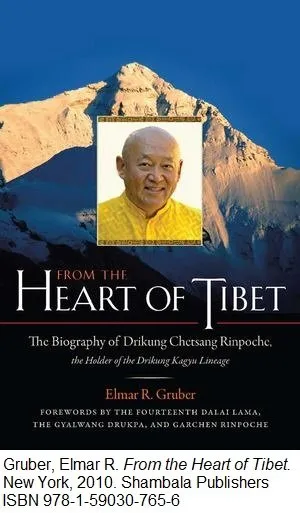Farewell to The Land of Snows
As I mentioned in a previous article, this was the final chapter of my 2021 "Year of Tibet." It was perhaps a fitting closure to the year, encompassing many of the topics already visited during the year. Like Sir Charles Bell's Biography of the 13th Dalai Lama, it is a biography of a high Tibetan Lama written by a Westerner. Like Falling Off the Roof of the World its central figure is a lama who was a child when the Communist Army invaded and occupied Tibet, and it covers his escape to the West. Like Warriors of Tibet, it contrasts life before, during, and after the Communist invasion, and outlines how the Chinese regime came first with words of peace and then with pogroms and death squads. Like so many of the books I've read this year, it addresses the history of Tibet, though in this case this is only discusses in a chapter devoted to the central Lama's lineage.
I suppose the best way to review this is by comparing it with Falling Off the Roof of the World.
One Hell of a Pedigree
The subject of this biography is the Chetsang Rinpoche, throne holder of the Kagyu school of Buddhism and one of the highest Lamas in Tibetan Buddhism. This incarnation was the grandson of "George" Tsarong, who figured centrally in Heinrich Harrer's Seven Years in Tibet due to his clsoe friendship with the author. George, in turn, was the son of a young Tibetan soldier who held off a platoon of Chinese troops to cover the 13th Dalai Lama's escape to India (Bell, 99). And finally, his sister's father-in-law was Shakabpa, the author of Tibet: A Political History, which is one of the premier sources referenced by both Laird and Smith.
The man is Amazingly well-connected, and seems to have ties to everyone in Tibet's modern history.
Much Darker in Tone
In Falling, the author does not dwell much on the atrocities witnessed by Lama Dorjee. In this book, the author places heavy emphasis on them. Indeed, the horrors the main character experiences living under the CPC regime take up the second and third quarters of the book. Attention is given to the PLA Air Force's bombing of Tibetan civilians in Lhasa (p. 92), which is essentially the only victory the PLA Air Force has ever enjoyed. The PLA's large-scale arrest and enslavement (without trial) of Tibetan civilians on fabricated charges of "aiding rebellion" is described (96 - 101). The entire second act of the book seems to revolve around the suffering of the Tibetan populace.
The most chilling thing though, is the frequently recurring theme of how the main character, the young Chetsang Rinpoche was browbeaten and brainwashed to actually accept this. The most glaring example is on pages 114 and 115. The Rinpoche took a bit of money to school to buy what passed for food in a Chinese middle school during the Cultural Revolution. This money was stolen by one of the other students (a Han of course). When Rinpoche reported the theft, the thief was quickly unmasked. However, the teacher assembled the entire class to rebuke not the thief but the Rinpoche, who was subjected to a twisted lecture in Communist dialectics and was forced to confess that the theft was his fault, both for bringing the money to school in the first place and for coming from an "oppressor class" who had money in the first place.
This was almost twisted enough to be the "Critical Race Theory" garbage that's running rampant under the banner of the CPC's North American subsidiary, the Democrat Party, in American schools today. It's enlightening to see, through a Tibetan Lama's eyes, just where this "it's your fault for not having as rough a life as I claim to have, and you were born an oppressor so live with the penalty we have ascribed to you" mentality came from.
No "Passive Acceptance" Here
One of the biggest differences between this and Falling is the central figure's response to his exile. While Lama Dorjee calmly accepts that his suffering was destined to happen, per the Buddhist principle of the impermanence of all things, Chetsang Rinpoche has devoted much of his life to the restoration of ancient Tibetan texts, not only of his own school but ALL schools of Tibetan Buddhism. His scholarly work, and sponsorship of scholarly work, in restoring Tibet's ancient languages, literature, and spiritual works, in an admirably fierce drive to reforge a Tibetan national identity that is under a four dimensional assault by China (it is not enough for them to destroy it; they seek to rewrite history and deny there ever was such an identity), is as awe-inspiring as it is daunting.
So Who Should Read It?
Well first of all, for a Tibetologist lamenting the rapid destruction of Tibetan cultural relics and the resulting deterioration of the Tibetan cultural identity, seeking to grasp onto some of its dwindling threads and help preserve them, this book is a light in the dark saying "I know how you feel and there is a powerful Lama on the same mission as you. Meet me in Dehra Dun."
But not everyone is a hard-core, serious Tibetologist. Some of us don't want to devote an entire year to studying a specific topic. So is it useful for anyone else? Honestly, if someone who knew nothing of Tibet came to me and asked "recommend one book you've read that will give me an insight into what the Tibetans have endured since the Chinese invasion"...
...Well okay, it'd be Warriors of Tibet by Jamyang Norbu. But if the same person finished that short little volume and then wanted something longer and more thorough, with a little more history, a few more detailed examples, and some trimmings instead of just meat and potatoes, I'd recommend this book as Level 2. A little Tibetan history, a bit of Tibetan cultural ethics, a bit of the history and doctrines of the Tibetan Buddhist Faith, this book gives a taste of all of it, even if it doesn't go into much detail about anything except the life of one man.
It's a crash course in everything I spent all of 2021 studying.

Works Cited
Dorjee, Dudjom. Falling Off the Roof of the World. Infinity Press. West Coshohoken. 2006.
ISBN 978-0-741-43-4302
Harrer, Heinrich. Seven Years in Tibet. New York, 1997. Putnam.
ISBN 978-08747-788-85
Laird, Thomas. The Story of Tibet – Conversations With the Dalai Lama. New York, 2006. Grove Press.
ISBN 978-0-8021-4327-3
Smith, Warren W. Jr. Tibetan Nation. Boulder, 1996. Westeview Press.
ISBN 978-8129114792
